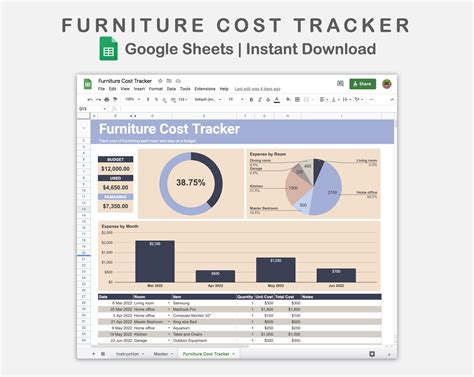Furnishing a House: Cost Calculator & Budget Planner
Furnishing a new house or even just refreshing your existing space can be an exciting but daunting task. The sheer number of choices, from sofas and armchairs to kitchenware and bedding, can quickly lead to budget overruns. This comprehensive guide provides a practical framework for calculating furnishing costs and creating a realistic budget, helping you create your dream home without breaking the bank.
Understanding Your Needs and Style
Before diving into cost calculations, it's crucial to define your needs and desired style. Consider these questions:
- What's your personal style? Modern minimalist? Rustic farmhouse? Knowing your style will help you narrow your options and avoid impulse purchases.
- What are your essential needs? Focus on the must-have items first (sofa, bed, dining table) before moving to decorative pieces.
- Who will be using the space? A family home requires different furnishings than a single-person apartment.
- What is the size of your rooms? Larger spaces require more furniture, naturally increasing the cost.
Creating Your Furnishing List
Once you have a clear idea of your needs and style, create a detailed list of items you need for each room. Be as specific as possible: instead of "sofa," write "three-seater grey fabric sofa." This level of detail helps you get accurate quotes and compare prices. Consider these categories:
- Living Room: Sofa, armchairs, coffee table, TV stand, rugs, lamps, curtains.
- Bedroom: Bed frame, mattress, bedside tables, dresser, wardrobe, bedding.
- Dining Room: Dining table, chairs, sideboard, buffet.
- Kitchen: Dining chairs (if separate from dining room), kitchen utensils, cookware, dinnerware.
- Bathroom: Towels, bath mats, shower curtain.
Estimating Costs: A Room-by-Room Approach
Estimating costs accurately requires a room-by-room breakdown. Research prices for similar items online and in local stores. Websites and stores like IKEA, Wayfair, and local furniture retailers can give you a starting point.
Tip: Factor in potential sales tax and delivery fees. These can significantly increase the overall cost.
How to Estimate Costs for Each Room
- Living Room: A sofa can range from $500 to $3,000+, while armchairs might cost $200-$1,000 each. Coffee tables can range from $100 to $500. Don't forget smaller items like cushions, throws, and lamps which can add up.
- Bedroom: A queen-size mattress can range from $500-$2,000. Bed frames, bedside tables, and dressers will add considerably to the cost.
- Dining Room: Dining sets vary greatly depending on material and size. Expect to pay anywhere from $300 to $3,000 or more.
- Kitchen: Kitchen essentials can be surprisingly expensive. Factor in the cost of cookware sets, dinnerware, and other kitchenware.
- Bathroom: Costs here are typically lower, with most expenses associated with towels, bath mats, and a shower curtain.
Developing Your Budget
Once you've estimated costs for each room, create a comprehensive budget. Consider these points:
- Total Estimated Cost: Add up the estimated costs for each room to get a preliminary total.
- Contingency Fund: Always include a contingency fund (10-20%) to cover unexpected expenses or price increases.
- Payment Plan: Determine how you'll finance your purchases. Will you pay in full, use a credit card, or finance the purchase?
- Prioritize: Rank your items by necessity. Focus on essential furniture first and gradually add decorative items.
Utilizing Online Furnishing Cost Calculators
Several online calculators can help streamline the budgeting process. These tools often offer a structured way to input room dimensions, desired furniture, and style preferences to generate estimated costs. While these calculators offer a convenient starting point, remember that they are estimations. Manual research can provide more accurate costing.
H2: What are some ways to save money when furnishing a house?
There are plenty of avenues to save money while furnishing your house. Consider exploring secondhand furniture stores, online marketplaces (like Craigslist or Facebook Marketplace), and participating in furniture auctions. Also, be open to buying individual pieces over time rather than furnishing an entire room at once. Prioritize and spread purchases over several months to manage your budget effectively.
H2: How long does it typically take to furnish a house completely?
The time it takes to fully furnish a house depends heavily on your budget and the speed at which you find the right pieces. Some people may opt to furnish everything quickly, while others take a more gradual approach, spreading purchases over several months or even years. Rushing the process might lead to poor choices; taking your time allows for careful selection and potentially better deals.
H2: Are there any hidden costs I should consider?
Yes, beyond the cost of the furniture itself, remember to factor in delivery fees, assembly costs (if needed), potential alterations or modifications, and sales tax. These "hidden costs" can quickly add up, so it's vital to include them in your budget.
Conclusion
Furnishing a house is a significant investment, both financially and emotionally. By carefully planning, researching, and utilizing the strategies outlined in this guide, you can create a comfortable and stylish home while managing your budget effectively. Remember to prioritize, research, and stay flexible throughout the process. Your dream home awaits!

